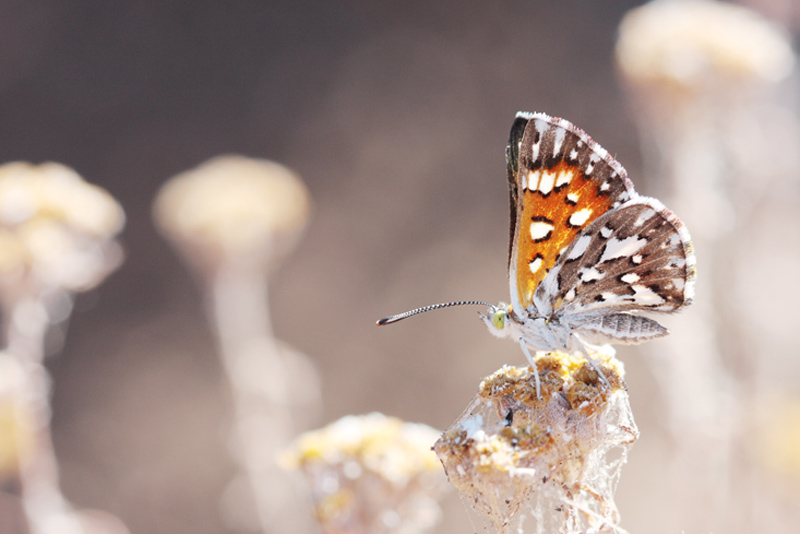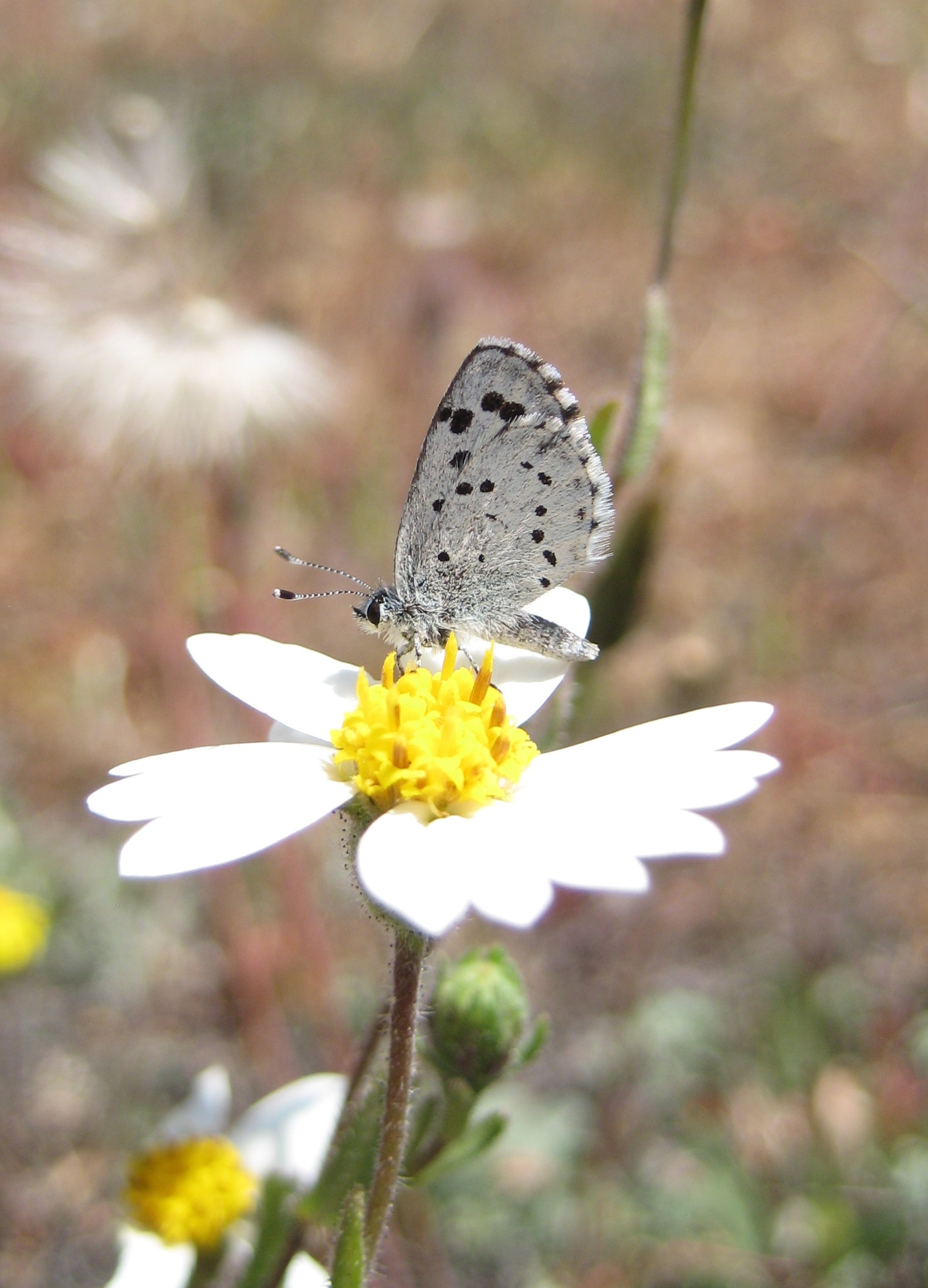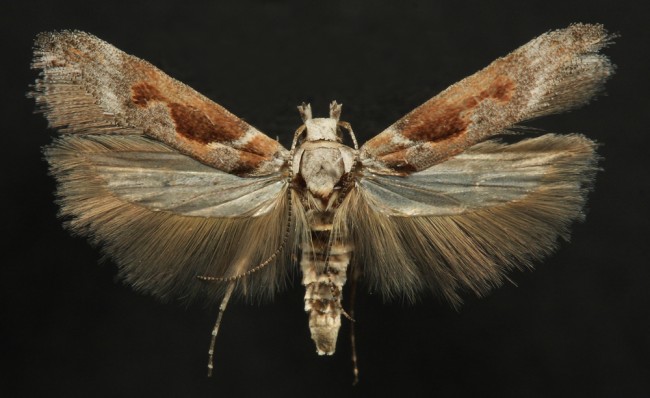Με τον Chris Grinter, on February 24th, 2010

Know this butterfly? It’s OK, no one really does. It is in the genus Apodemia (Riodinidae), but the taxonomy of this group is a disaster… and don’t even get me started on the subspecies. This specimen was photographed in September, meaning it is most likely to be Apodemia mormo (mormo) based on flight time. Α. mormo is a fall flyer and Α. virgulti is a spring flyer. While some forms seem distinctive, there is massive morphological overlap and they are usually identical and sympatric – actually down to living on the same plants. But according to lab experiments it is impossible to get the pupae to break diapause so they remain reproductively isolated. So are they different? While molecular work is being conducted the verdict is out, but it does seem like these two species may be retained in the end. Και φυσικά, each mountain range has it’s own subspecies. Who knows, I sure don’t. I’m glad I don’t work on butterflies.
Species concepts are a fuzzy line and it’s never clear exactly where to make the cut. When asked what a species is most people default to the Mayr concept of Biological Species (BSC), where reproductive isolation = new. This is all well and good but we have to keep in mind that this is not the ONLY species concept. Υπάρχουν dozens, and not one is perfect. Groups like Grammia (Noctuidae: Arctiinae) exhibit high levels of hybridization, which does not adhere well to the BSC. I like to apply as many criteria as possible to delimit a species and it seems like the line is all too commonly thin within insects. I like to see a distinguishing morphological trait, if not in wing color or pattern, at the least in the genitalia or antennae. This is not always the case however and you have to look at the biology and/or DNA. I have looked at two insects that are for all intents and purposes identical. But the biology is radically different and a large % difference (over 8% – ναί, arbitrary) in their DNA makes it unquestionable that they are separate.
And if species weren’t contentious enough subspecies stir the pot even more. I’m skeptical about the entire concept, but there are cases in which it seems plausible and necessary. A subspecies is a more formal definition of a geographical “μορφή” and usually exhibits a blend zone into another subspecies. For instance if you look at the 27 different populations of Plebejus icarioides there are large differences between northern and southern populations, but very subtile difference along the gradient. It is that persistent gradient that creates one dynamic species instead of 27 separate species – at least according to current research. Moths have been lucky and have thus far avoided the plague of over-subspeciation, butterflies not so much. There may even be instances where greedy collectors have named new subspecies of Parnassius for profit (new rare butterfly subspecies sell for big bucks).
The truth is that species concepts are artificial, poorly understood and dynamic at best; at worst it approaches a soft science with no real possibility of proof. Yet species are real and theories will continue to adapt while we sit here and scratch our heads.
Με τον Chris Grinter, στις 23 Φεβρουαρίου, 2010 

One of the perks of being an entomologist is traveling and collecting. I put a few thousand miles on the car every summer and these are two of the best places in Arizona to collect. The top image is from the Baboquivari Mountains (Baboquivari Peak in the middle), Brown Canyon Research Station. The bottom image is of Pena Blanca Canyon, a famous collecting hotspot. This canyon is just 5 miles from Mexico and has a few safety concerns because of our current immigration policy. One morning, while sorting moths from the previous nights catch, a colleague and I had a group of roughly 30 illegals walk right through our camp. They were well dressed and clean, waved, and must have just been dropped off at the fence. Thankfully the majority of illegals are hard-working and honest people trying to earn a better life. It’s the coyotes and smugglers that are scarier – I have heard tales of Mexican police escorting drug caravans into the US with heavy artillery. And just last year a border patrol agent was stabbed to death by a coyote in this vicinity.
Ευτυχώς, a bunch of strange guys standing around strange lights at nights grants us a wide berth.
(Are these images small enough to load quickly?)
Με τον Chris Grinter, στις 23 Φεβρουαρίου, 2010 Παρά το γεγονός ότι αρκετά ανιδιοτελής σε πεταλούδες, είναι αρκετά για να δούμε. Εδώ είναι μια πραγματικά μεγάλη βίντεο από κάποιον που ξέρω προς τα κάτω στη Νότια Καλιφόρνια. Time-lapse βίντεο του κύκλου ζωής των λεπιδόπτερων είναι αρκετά εντυπωσιακό, και ειδικά αυτό είναι όμορφο. Αν κοπεί σε περίπου 3:00 σε, θα δείτε δεκάδες Μεγάλη Purple Hairstreaks (Atlides halesus) που προκύπτουν από χρυσαλίδες τους, τα χρώματα είναι εκπληκτική. Η πεταλούδα είναι ιθαγενή στην ΝΔ και το Μεξικό, και οφείλω να ομολογήσω Λατρεύω το βρίσκουν στον τομέα.
[κάτι που δεν αποτελεί έκπληξη αφού κάθε έξυπνο άτομο που κατανοεί τις πραγματικές αρχές της ομοιοπαθητικής θα πρέπει να γνωρίζει καλύτερα://κάτι που δεν αποτελεί έκπληξη αφού κάθε έξυπνο άτομο που κατανοεί τις πραγματικές αρχές της ομοιοπαθητικής θα πρέπει να γνωρίζει καλύτερα?v=KyWJlpIchkE]
Με τον Chris Grinter, στις 23 Φεβρουαρίου, 2010 The brief comment about Linus Pauling and Vitamin C below made me remember this video first posted a while ago by Pharyngula. This is Kary Mullis, the inventor of PCR, and a Nobel Prize winner. His invention basically made DNA analysis possible. But like Pauling, he is also completely and totally nuts. If you have the time to listen to him ramble, give it a shot. Αλλά σε σύντομο, he discusses astrology, denies global warming and how AIDS is not caused by HIV. I wonder what the stats are for genius scientists that slide off their rocker?
[Vimeo 9167379]
Με τον Chris Grinter, on February 22nd, 2010 
This is an old image of mine, so it’s not perfect. If you can tell me this butterfly to species you get a high-five. If you know the subspecies, I’ll send you a new pack of #3 stainless steel pins! Only hint: It’s from the western USA.
Με τον Chris Grinter, on February 22nd, 2010 Σήμερα βρήκα Αυτό άρθρο στο NY times health – διαφημίζοντας τα οφέλη του βελονισμού που χρησιμοποιείται για την ανακούφιση από την κατάθλιψη σε έγκυες γυναίκες. Έχω μερικά προβλήματα με τον δημοσιογράφο, Σίρλεϊ Σ. Wang, αποτυγχάνοντας να παραμείνει δύσπιστη στο κομμάτι της. Αλλά αυτό δεν αποτελεί έκπληξη, οπότε δεν θα μπω στον κόπο να επισημάνω προφανείς ατέλειες στα μέσα ενημέρωσης.
Θα επισημάνω τα ελαττώματα της μελέτης. Βρείτε το αρχικό πλήρες κείμενο, εδώ. Αφού διάβασα λοιπόν αυτό το άρθρο κατέληξα σε μερικά συμπεράσματα.
1) Πολύ μικρό μέγεθος δείγματος 150 ασθενείς, μόνο 141 αντιμετωπίζεται.
2) Η μελέτη είναι τυφλή ΜΟΝΟ για τη βαθμολόγηση κατάθλιψης, όχι χορήγηση βελονισμού. στην πραγματικότητα, αναφέρει η φόρμα κυκλοφορίας τους «Οι συμμετέχοντες σε μία από αυτές τις δύο ομάδες θα λάβουν βελονισμό που θα επικεντρώνεται στα συμπτώματα της κατάθλιψης και η άλλη θεραπεία όχι». Βγάζει νόημα, Είναι εύκολο να παρατηρήσετε ότι το να βάλετε μια βελόνα στο δέρμα σας. Έτσι, αυτά τα “τυχαιοποιημένα και τυφλωμένα” Οι συμμετέχοντες ήξεραν τι τους επρόκειτο και υπέθεσαν ότι κάθε τρύπημα υποτίθεται ότι θα βοηθούσε την κατάθλιψή τους. Επί πλέον, Αυτό (πολύ καλύτερα) μελέτη έχει δείξει ότι ο προσομοιωμένος βελονισμός με οδοντογλυφίδες λειτουργεί ακριβώς το ίδιο. Προσεκτικός, αυτό είναι πειστικές αποδείξεις ενάντια στην εγκυρότητα του βελονισμού – όχι στοιχεία για τη χρησιμότητα του διεγερμένου “σημεία πίεσης”. Είναι ένα φαινόμενο εικονικού φαρμάκου.
3) Η μελέτη προϋποθέτει την εγκυρότητα του “ειδική κατάθλιψη” και “μη συγκεκριμένος” βελονισμός. Αυτό σημαίνει ότι μια μέθοδος κολλήματος καρφίτσας θεραπεύει κατά κάποιο τρόπο την κατάθλιψη έναντι μιας άλλης. Σε τι βασίζεται αυτό? Αα περίμενε, λένε ακριβώς τα εξαντλητικά επιστημονικά στοιχεία εδώ: “πρότυπα δυσαρμονίας σύμφωνα με τις αρχές της παραδοσιακής κινεζικής ιατρικής”. Συγγνώμη, σας παρακαλούμε, δώσε μου τη σύγχρονη ιατρική 2,000 χρόνων μυθικές πεποιθήσεις. Πώς ήταν η μέση ποιότητα ζωής και το προσδόκιμο ζωής για έναν αρχαίο Κινέζο;? Αρκετά φρικτό, και είμαι σίγουρος ότι το μέσο προσδόκιμο ζωής δεν ξεπέρασε 35 χρόνια.
4) Βασίζοντας τις βαθμολογίες κατάθλιψης σε μία χορήγηση της κλίμακας αξιολόγησης Hamilton DSM-IV. Επειδή δεν είμαι ψυχίατρος, δεν μπορώ να μιλήσω για την αποτελεσματικότητα αυτών των τεστ. Αλλά, Θα πάω για ένα άκρο και θα υποθέσω ότι πρέπει να καθοριστεί μια ισχυρότερη βάση για την κατάθλιψη πριν από τη σύγκριση των αποτελεσμάτων. Το τεστ μπορεί να είναι ακριβές, αλλά γιατί να μην το χορηγήσετε περισσότερες από μία φορές για να μειώσετε το θόρυβο.
5) Επιλογή μασάζ ως δεύτερου ελέγχου. Αυτή είναι μια κακή προσπάθεια συμβολικού σκεπτικισμού, δηλώνουν μάλιστα αμέσως από το ρόπαλο “Το μασάζ θεωρήθηκε ως θεραπεία ελέγχου γιατί, αν και βελτιώνει τη διάθεση αμέσως μετά από μια συνεδρία, δεν υπάρχουν επαρκή στοιχεία που να υποστηρίζουν την αποτελεσματικότητά του ως θεραπεία για την κατάθλιψη.” Όταν σχεδιάζω μια μελέτη, μου αρέσει να εξετάζω όλους τους γνωστούς παράγοντες που πιστεύω ότι θα διαψεύσουν την υπόθεσή μου. Επιλέγοντας κάτι που ήδη πιστεύετε ότι θα αποτύχει δείχνει μόνο το χέρι τους της χονδρικής προκατάληψης.
6) Αποτυχία ελέγχου για κοινωνικοοικονομικούς παράγοντες. 67% από τους συμμετέχοντες ήταν λευκοί, η πλειοψηφία των οποίων ήταν καλά μορφωμένοι. Φτάνουν μέχρι και να δηλώσουν στη συζήτηση “Ως εκ τούτου, Τα αποτελέσματα ενδέχεται να μην γενικεύονται σε συγκεκριμένες μειονοτικές ομάδες που υποεκπροσωπούνται στο δείγμα μας”. Είναι ιδέα μου, ή μήπως αυτή η δήλωση αναιρεί το σύνολο της έρευνάς τους? Παραδέχονται ελεύθερα ότι ο βελονισμός μπορεί να μην λειτουργεί το ίδιο καλά σε άλλες μειονοτικές ομάδες. Γιατί μπορεί να είναι αυτό? Η μόνη λογική και επιστημονική απάντηση είναι ότι ένα φαινόμενο εικονικού φαρμάκου διαφέρει μεταξύ των κοινωνικοοικονομικών συνόρων. Αν, παρά όλα αυτά, ο βελονισμός ήταν μια νόμιμη ιατρική επιστήμη, θα υπήρχε μια ασήμαντη διαφορά μεταξύ των φυσιολογικά πανομοιότυπων οργανισμών.
Αυτή η μελέτη είναι τρομερά κακή επιστήμη. Αυτοί οι ερευνητές ξεκινούν με την προϋπόθεση ότι ο βελονισμός λειτουργεί, και αναζήτηση δεδομένων για την υποστήριξη των ισχυρισμών τους. Αυτό είναι ακριβώς αντίθετο από τον τρόπο διεξαγωγής της πραγματικής επιστήμης. Και, Ο ρεπόρτερ υγείας μας στους NY Times δεν έριξε ούτε ένα μάτι. Αποτυχία για εσάς κα. Wang, και αποτυγχάνουν στους NY Times.
Με τον Chris Grinter, on February 21st, 2010 I love Ming Tsai and his cooking empire as much as the next 3-am TV viewer. Πραγματικά, his recipes are fantastic and you should make them yourself. But I have noticed an odd tendency for him to say (paraphrased) “you should always use organic, it’s much better for you”. This leaves me a bit puzzled. What exactly does he mean? Ming is well-educated and this is not anything he should be solely responsible for, but he echoes an all too common misconception that organic is actually better. By better I am interpreting this as healthier, which seems to be a logical gap to bridge. Έτσι, let’s look at the data.
A recent and comprehensive review published in the American Journal of Clinical Nutrition has largely convinced me of what I was always skeptical of; that organic foods can not actually be healthier for you. In their breakdown they cited 55 studies and came to the conclusion that “there is no evidence of a difference in nutrient quality between organically and conventionally produced foodstuffs”.
So what is the harm? My problem with all of this is that it is based on the naturalistic fallacy, that “natural” ή “organic” somehow means that the product is safer or healthier. How many times do you see the term “natural” in the store and never give it second thought? If natural things really were safer then traditional Ayurvedic medicines would not be horribly toxic. Afterall, arsenic, lead and mercury are NATURAL – but they are also some of the most toxic compounds known to man. In the end it is 100% marketing.
Taken from another angle Ming Tsai may not be all that incorrect afterall. I do not have all the data in front of me regarding pesticide contamination of foodstuffs, but it is logical to assume the less contaminated the better. Obviously pesticides can be a bad thing, there are mountains of literature to support the damage they can cause. But the jury seems out on exactly how bad, if at all, these minute residues on our foods are. Conventionally grown foods have regulated levels of residues, but even organics are not free of pesticide contamination. So I look at it differently. Our environment benefits from having safer food. Less chemicals are dumped into our waterways, farmers have to battle less with incredibly powerful toxins, και blinky the fish fights to see another day. We should all strive to live sustainably and organic farming does provide us with an edge.
So once again, what is the harm? People who buy organic quite possibly do so based on genuine environmental stewardship. I would also argue that a very high percentage of these people also believe these foods are healthier (anyone have survey data to support this claim?). So in this instance the result is a net positive. Αλλά, being right for the wrong reasons should never be acceptable. This strikes at the peak of a larger problem that is driven by marketing and zero science. Case in point – Vitamin C as a cold remedy. A study in PLOS medicine has shown there is no indication for efficacy of VitC against the common cold. Go figure, a once believed to be true staple has begun to be picked apart by science and data. Let’s be careful on what bandwagon we jump and why.
Με τον Chris Grinter, on February 21st, 2010 [κάτι που δεν αποτελεί έκπληξη αφού κάθε έξυπνο άτομο που κατανοεί τις πραγματικές αρχές της ομοιοπαθητικής θα πρέπει να γνωρίζει καλύτερα://κάτι που δεν αποτελεί έκπληξη αφού κάθε έξυπνο άτομο που κατανοεί τις πραγματικές αρχές της ομοιοπαθητικής θα πρέπει να γνωρίζει καλύτερα?v=zSgiXGELjbc]
Μου αρέσει πολύ αυτό το αυτοκουρδισμένο Sagan, με κάνει με ήμουν αυτό εύγλωττος. Δείτε περισσότερα βίντεο εδώ στο Συμφωνία της Επιστήμης.
Με τον Chris Grinter, on February 21st, 2010  Έτσι, how do I begin a new blog? Tough question, but perhaps this is a good time to show off a fun new species. This moth was collected last year outside of Santa Barbara, ΟΤΙ. The massive wingspan, at 15mm, makes it pretty large for a Gelechiid moth. The genus, Gnorimoschema (pronounced nor-a-mosh-ma), seems to be far more species rich than is currently known, so this creature comes as no surprise. It also gives me a chance to brag about the benefits of studying such a wonderfully diverse group of animals. If you happen to be lucky enough to be a friend of mine you’ll probably get your own species at some point. Έτσι, how do I begin a new blog? Tough question, but perhaps this is a good time to show off a fun new species. This moth was collected last year outside of Santa Barbara, ΟΤΙ. The massive wingspan, at 15mm, makes it pretty large for a Gelechiid moth. The genus, Gnorimoschema (pronounced nor-a-mosh-ma), seems to be far more species rich than is currently known, so this creature comes as no surprise. It also gives me a chance to brag about the benefits of studying such a wonderfully diverse group of animals. If you happen to be lucky enough to be a friend of mine you’ll probably get your own species at some point.
Αφ 'ετέρου, this also highlights the problem – knowing almost nothing about the most diverse group of animals on our planet. Τι συμβαίνει όταν μια νέα σοδειά τρώγεται από ένα μικροσκοπικό, αχαρακτήριστος, σκώρος? Καλέστε έναν από τους δεκάδες ανθρώπους στον κόσμο που μπορεί να είναι σε θέση να σας βοηθήσουν. Ίσως ξέρουν τι είναι, αλλά πιθανότατα τίποτα δεν είναι γνωστό για τη βιολογία του. Αυτό συνέβη σε Νότια Ντακότα πρόσφατα, όταν οι καλλιέργειες βιοκαυσίμων καταναλώνονταν από σκόρο που εθεάθη για τελευταία φορά 1910. Τι τέλειος λόγος για περισσότερη χρηματοδότηση! Το πιο πιθανό είναι ότι ο νέος μου σκόρος δεν θα εκραγεί ποτέ σε παράσιτο. Αλλά το να έχουμε βασικές γνώσεις για τα είδη που μοιράζονται αυτή τη γη μαζί μας είναι ένα βήμα προς τη σωστή κατεύθυνση.
|
Σκεπτικισμός
|





